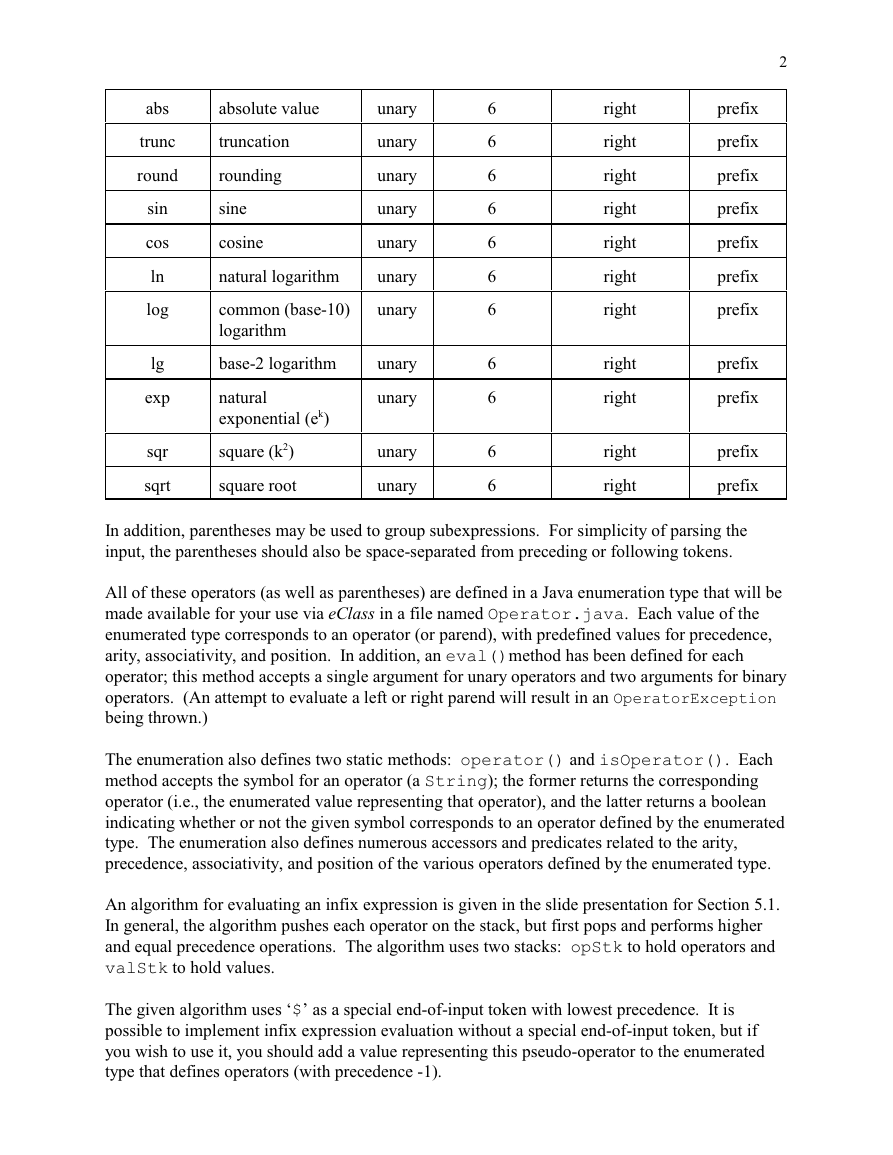AUCSC 210 Algorithm Analysis and Data Structures
Programming Assignment 1: Infix Expression Evaluation
Due date: Oct. 8 (by midnight)
Objectives
• To gain understanding of how an implementation of an ADT is used by an application
program.
• To learn how expressions can be evaluated at run-time.
• To become familiar with how infix expressions can be converted to postfix expressions.
Assignment
Write a Java program (a collection of Java classes), including a class named
InfixExpressionEvaluator that contains a static main method. This main method will
prompt the user to enter a constant expression (i.e., a mathematical expression without variables)
at the keyboard. The expression must be in infix notation and must use spaces to separate the
tokens (operands and operators) of the expression. (This restriction is imposed to simplify the
parsing of the input.) The only exception to the space-separation rule is for the unary minus
prefix operator, which will be assumed to be part of the specification of a negative constant
operand. The program will then evaluate the expression and display the result on the console. It
will then wait for another expression to be entered for evaluation, terminating on an empty input.
The following operators should be supported by your expression calculator:
OPERATOR
DESCRIPTION
+
-
*
/
mod
^
!
%
addition
subtraction
multiplication
division
remainder
exponentiation
factorial
percentage
ARITY
binary
binary
binary
binary
binary
binary
unary
unary
PRECEDENCE ASSOCIATIVITY
POSITION
4
4
5
5
5
6
6
6
left
left
left
left
left
right
right
right
infix
infix
infix
infix
infix
infix
postfix
postfix
�
abs
trunc
round
sin
cos
ln
log
lg
exp
sqr
sqrt
absolute value
truncation
rounding
sine
cosine
natural logarithm
common (base-10)
logarithm
base-2 logarithm
natural
exponential (e )k
square (k )
2
square root
unary
unary
unary
unary
unary
unary
unary
unary
unary
unary
unary
6
6
6
6
6
6
6
6
6
6
6
2
prefix
prefix
prefix
prefix
prefix
prefix
prefix
prefix
prefix
prefix
prefix
right
right
right
right
right
right
right
right
right
right
right
In addition, parentheses may be used to group subexpressions. For simplicity of parsing the
input, the parentheses should also be space-separated from preceding or following tokens.
All of these operators (as well as parentheses) are defined in a Java enumeration type that will be
made available for your use via eClass in a file named Operator.java. Each value of the
enumerated type corresponds to an operator (or parend), with predefined values for precedence,
arity, associativity, and position. In addition, an eval()method has been defined for each
operator; this method accepts a single argument for unary operators and two arguments for binary
operators. (An attempt to evaluate a left or right parend will result in an OperatorException
being thrown.)
The enumeration also defines two static methods: operator() and isOperator(). Each
method accepts the symbol for an operator (a String); the former returns the corresponding
operator (i.e., the enumerated value representing that operator), and the latter returns a boolean
indicating whether or not the given symbol corresponds to an operator defined by the enumerated
type. The enumeration also defines numerous accessors and predicates related to the arity,
precedence, associativity, and position of the various operators defined by the enumerated type.
An algorithm for evaluating an infix expression is given in the slide presentation for Section 5.1.
In general, the algorithm pushes each operator on the stack, but first pops and performs higher
and equal precedence operations. The algorithm uses two stacks: opStk to hold operators and
valStk to hold values.
The given algorithm uses ‘$’ as a special end-of-input token with lowest precedence. It is
possible to implement infix expression evaluation without a special end-of-input token, but if
you wish to use it, you should add a value representing this pseudo-operator to the enumerated
type that defines operators (with precedence -1).
�
The pseudocode for the algorithm as given in the slides is:
Algorithm doOp()
x 7 valStk.pop();
y 7 valStk.pop();
op 7 opStk.pop();
valStk.push( y op x )
3
Algorithm repeatOps( refOp ):
while ( valStk.size() > 1 ^
prec(refOp) # prec(opStk.top())
doOp()
Algorithm EvalExp()
Input: a stream of tokens representing an arithmetic expression (with numbers)
Output: the value of the expression
while there’s another token z
if isNumber(z) then
else
valStk.push(z)
repeatOps(z);
opStk.push(z)
repeatOps($);
return valStk.top()
Note that this algorithm does not work correctly for right-associative operators such as ‘^’. The
expression 2 ^ 3 ^ 4 should evaluate as 2 ^ (3 ^ 4), not as (2 ^ 3) ^ 4. You will have to adjust the
algorithm so that it correctly evaluates expressions including right-associative operators.
Hint
Use Java’s StringTokenizer or the Scanner class of Java 5 (and later versions) to parse
expressions. The latter offers the methods hasNextType and nextType (where Type is
replaced by Integer, Double, etc.), which would be convenient for checking if the next token
in an expression can be parsed as a Double and is thus an operand.
Submission
Use the assignment submission form that will be provided in eClass to submit your solution to
this assignment. It would be preferred if you submitted your code as a NetBeans project in a ZIP
file, but an Eclipse project or a collection of Java source files (‘*.java’) in a ZIP archive will be
acceptable.
Late submissions will be assessed a penalty of 1% per hour or portion of an hour.
�






 2023年江西萍乡中考道德与法治真题及答案.doc
2023年江西萍乡中考道德与法治真题及答案.doc 2012年重庆南川中考生物真题及答案.doc
2012年重庆南川中考生物真题及答案.doc 2013年江西师范大学地理学综合及文艺理论基础考研真题.doc
2013年江西师范大学地理学综合及文艺理论基础考研真题.doc 2020年四川甘孜小升初语文真题及答案I卷.doc
2020年四川甘孜小升初语文真题及答案I卷.doc 2020年注册岩土工程师专业基础考试真题及答案.doc
2020年注册岩土工程师专业基础考试真题及答案.doc 2023-2024学年福建省厦门市九年级上学期数学月考试题及答案.doc
2023-2024学年福建省厦门市九年级上学期数学月考试题及答案.doc 2021-2022学年辽宁省沈阳市大东区九年级上学期语文期末试题及答案.doc
2021-2022学年辽宁省沈阳市大东区九年级上学期语文期末试题及答案.doc 2022-2023学年北京东城区初三第一学期物理期末试卷及答案.doc
2022-2023学年北京东城区初三第一学期物理期末试卷及答案.doc 2018上半年江西教师资格初中地理学科知识与教学能力真题及答案.doc
2018上半年江西教师资格初中地理学科知识与教学能力真题及答案.doc 2012年河北国家公务员申论考试真题及答案-省级.doc
2012年河北国家公务员申论考试真题及答案-省级.doc 2020-2021学年江苏省扬州市江都区邵樊片九年级上学期数学第一次质量检测试题及答案.doc
2020-2021学年江苏省扬州市江都区邵樊片九年级上学期数学第一次质量检测试题及答案.doc 2022下半年黑龙江教师资格证中学综合素质真题及答案.doc
2022下半年黑龙江教师资格证中学综合素质真题及答案.doc